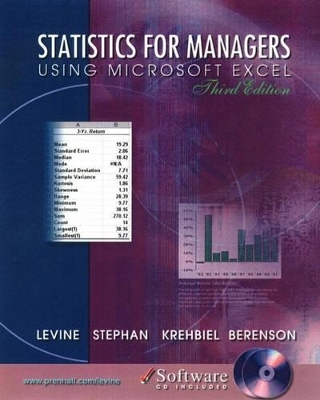
Statistics for Managers Using Microsoft Excel
Pearson
978-0-13-097082-4 (ISBN)
- Titel erscheint in neuer Auflage
- Artikel merken
This hallmark text was the first to thoroughly integrate the use of Microsoft Excel and still provides more Excel coverage than any other textbook. The streamlined coverage (15 chapters) focuses on the concepts of statistics with applications to the functional areas of business. It is rich with applications from accounting, finance, marketing, management and economics. There is significant emphasis on using statistical software as a tool, with most examples presented in a spreadsheet environment. This is the #1 best-selling business statistics text!
1. Introduction and Data Collection Excel Primer.
Why a Manager Needs to Know about Statistics. The Growth and Development of Modern Statistics. What Every Manager Needs to Know about Using Electronic Spreadsheets. What you Need to know About Using the Software for This Textbook. Why Data are Needed. Sources of Data. Types of Data. Types of Sampling Methods. Evaluating Survey Worthiness.
2. Presenting Data in Tables and Charts.
Organizing Numerical Data. Tables and Charts for Numerical Data. Graphing Bivariate Numerical Data. Tables and Charts for Categorical Data. Tabulating and Graphing Bivariate Categorical Data. Graphical Excellence.
3. Numerical Descriptive Measures.
Exploring Numerical Data and Their Properties. Measure of Central Tendency, Variation, and Shape. Exploratory Data Analysis. Obtaining Descriptive Summary Measures from a Population. The Coefficient of Correlation. Pitfalls in Numerical Descriptive Measures and Ethical Issues.
4. Basic Probability and Discrete Probability Distribution.
Basic Probability Concepts. Conditional Probability. Bayes' Theorem. The Probability Distribution for a Discrete Random Variable. Covariance and Its Application to Finance. Binomial Distribution. Poisson Distribution. Hypergeometric Distribution. Ethical Issues and Probability.
5. The Normal Distribution and Sampling Distributions.
The Normal Distribution. Evaluating the Normality Assumption. The Exponential Distribution. Introduction to Sampling Distributions. Sampling Distribution of the Mean. Sampling Distribution of the Proportion. Sampling from Finite Populations (CD-ROM Topic).
6. Confidence Interval Estimation.
Confidence Interval Estimation of the Mean (… Known). Confidence Interval Estimation of the Mean (… Unknown). Confidence Interval Estimation for the Proportion. Determining Sample Size. Applications of Confidence Interval Estimation in Auditing. Confidence Interval Estimation and Ethical Issues. Estimation and Sample Size Determination for Finite Populations (CD-ROM Topic).
7. Fundaments of Hypothesis Testing: One-Sample Tests.
Hypothesis Testing Methodology. Z Test of Hypothesis for the Mean (… Known). One-Tail Tests. t Test of Hypothesis for the Mean (… Unknown). Z Test of Hypothesis for the Proportion. Potential Hypothesis-Testing Pitfalls and Ethical Issues.
8. Two-Sample Tests with Numerical Data.
Comparing Two Independent Samples: t Tests for Differences in Two Means. F Test for Differences Between Two Variances. Comparing Two Related Samples: Test for the Mean Difference. Wilcoxon Rank Sum Test for Differences in Two Medians.
9. Analysis of Variance.
The Completely Randomized Design: One-Way Analysis of Variance. The Two-Factor Factorial Design: Two-Way Analysis of Variance. The Kruskal-Wallis Rank Test for Differences Between Medians.
10. Tests for Two or More Samples with Categorical Data.
Z Test for the Differences Between Two Proportions. …2 Test for the Difference Between Two Proportions. …2 Test for Differences in More Than Two Proportions. …2 Test of Independence.
11. Simple Linear Regression.
Types of Regression Models. Determining the Simple Linear Regression Equation. Measures of Variation. Assumptions. Residual Analysis. Measuring Autocorrelation: The Durbin-Watson Statistic. Inferences about the Slope and Correlation Coefficient. Estimation of Mean Values and Prediction of Individual Values. Pitfalls in Regression and Ethical Issues. Computations in Simple Linear Regression.
12. Multiple Regression.
Developing the Multiple Regression Model. Residual Analysis for the Multiple Regression Model. Testing for the Significance of the Multiple Regression Model. Inferences Concerning the Population Regression Coefficients. Testing Proportions of the Multiple Regression Model. The Quadratic Regression Model. Dummy Variable Models. Using Transformations in Regression Models. Collinearity. Model Building. Pitfalls in Multiple Regression and Ethical Issues.
13. Time-Series Analysis.
The Importance of Business Forecasting. Component Factors of the Classical Multiplicative Time-Series Model. Smoothing the Annual Time Series. Least-Squares Trend Fitting and Forecasting. Autoregressive Modeling for Trend Fitting and Forecasting. Choosing an Appropriate Forecasting Model. Time-Series Forecasting of Monthly or Quarterly Data. Pitfalls Concerning Time-Series Analysis. Index Numbers (CD-ROM Topic).
14. Decision Making.
The Payoff Table and Decision Trees. Criteria for Decision Making. Decision Making with Sample Information. Utility.
15. Statistical Applications in Quality and Productivity Management.
Quality and Productivity: A Historical Perspective. Deming's 14 Points: A Theory of Management. The Theory of Control Charts. Control Chart for the Proportion of Nonconforming Items: p Charts. The Red Bead Experiment: Understanding Process Variability. Control Charts for the Range and the Mean. Process Capability.
| Erscheint lt. Verlag | 24.8.2001 |
|---|---|
| Sprache | englisch |
| Maße | 205 x 254 mm |
| Gewicht | 1652 g |
| Themenwelt | Informatik ► Office Programme ► Excel |
| Mathematik / Informatik ► Mathematik ► Statistik | |
| Wirtschaft ► Betriebswirtschaft / Management ► Unternehmensführung / Management | |
| ISBN-10 | 0-13-097082-4 / 0130970824 |
| ISBN-13 | 978-0-13-097082-4 / 9780130970824 |
| Zustand | Neuware |
| Haben Sie eine Frage zum Produkt? |